Masterpiece Story: Statue of Liberty
On a small island just out of New York City’s harbor, Lady Liberty greets anyone arriving in the United States from the Atlantic Ocean. Over the...
Anastasia Manioudaki 7 November 2024
Mary Beale is a rarity: a prolific, well-documented, successful, 17th-century woman artist. Her painting of Young Bacchus perfectly illustrates how she balanced the competing demands of being a businesswoman, wife and mother, and creative artistic innovator.
Mary Beale was born into a rural community in England in 1633. Her father, a rector, was an amateur artist who probably encouraged his daughter’s talent. Little is known about her artistic training, but she was great friends with Sir Peter Lely, court painter and leading portraitist of the day. Not only is their work stylistically similar, but they were close neighbors after the newly married Beale moved to London in the early 1650s. Lely gave her paintings to copy as a way of refining her technique. The Beale family also commissioned portraits from him, including one of the eldest son, Bartholomew, which allowed Mary to study how the artist worked.
Building up her career slowly, Beale started painting for friends on a semi-professional basis. It was difficult for a woman to invite strangers, especially men, into her home, and Beale was careful to establish and preserve her “virtuous reputation.” Her husband, Charles Beale, frequently recorded sitters as “persons of quality.”
Beale was also lucky enough to know some influential patrons. For instance, she was a friend of John Tillotson, who became archbishop of Canterbury. She painted at least five portraits of him, including one that hangs in St Paul’s Cathedral.
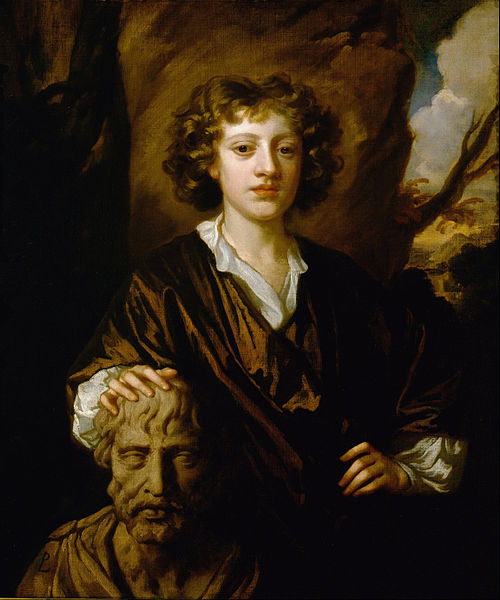
Peter Lely, Bartholomew Beale, c. 1670, Dulwich Picture Gallery, London, UK.
By the 1670s, Beale was earning enough for her husband to give up his work as a civil service clerk and become her full-time assistant. He kept copious notebooks, which provided unusually detailed insight into Mary’s practice. We know, for instance, that in 1677, she had 83 commissions, that she charged £5 for paintings of head and shoulders and £10 for a half-length portrait, what pigments she used, and the costs of her materials.
Lely died in 1680, leaving a new generation of artists to take portraiture in different directions. Mary Beale’s style was so closely associated with Lely’s that her popularity also waned. She took on two female students in the 1680s, possibly as a way of making some extra money. Her later career saw fewer large and more expensive, three-quarter-length portraits, but she continued to find patrons until her death in 1699.
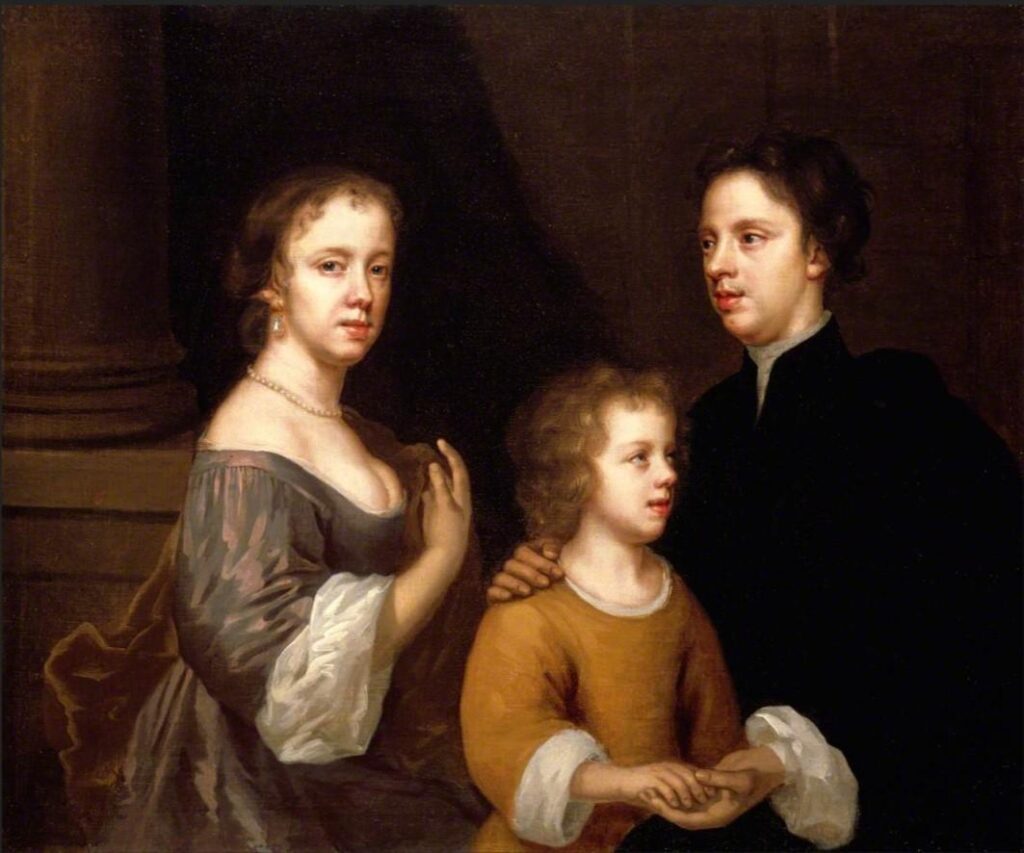
Mary Beale, Self-Portrait with Husband and Son, c. 1659–1660, Museum of the Home, London, UK.
Mary Beale was unusual in many ways, not least because she did not give up her artistic career when she married and became a mother. Right into the 20th century, the art world is littered with examples of women who chose or felt pressured, to give up painting professionally and put their families first. In fact, in the Beale household, painting remained not just the family business but seems to have provided a genuine bond between husband, wife, and children.
Beale’s first child died in infancy. Her second, Bartholomew, or Batt as he was affectionately known, was born in 1656. It is Batt who posed for Young Bacchus. He, along with his younger brother Charles, born in 1660, is featured in several paintings, as well as in informal sketches, which are obviously the work of a mother recording her children.
The family portrait from 1659–60 shows Mary with her husband and son, and most likely pregnant with Charles. Strikingly, the husband and son, Batt, are positioned together, with Mary sitting slightly apart, looking out of the canvas in an act of self-assertion.
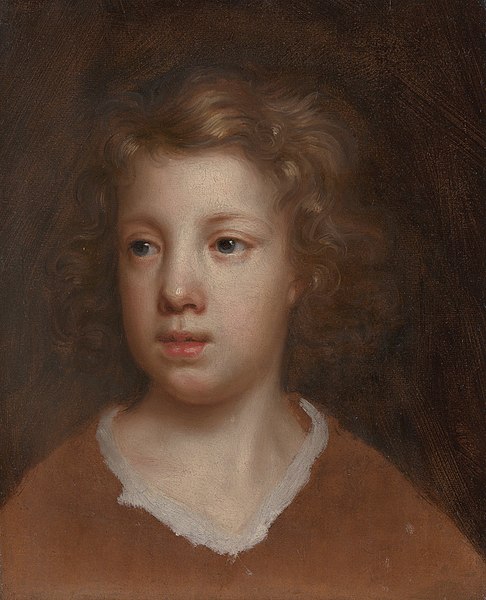
Mary Beale, Portrait of Bartholomew Beale, Yale Center for British Art, New Haven, CT, USA.
Both boys were employed in the family studio, mixing pigments and painting draperies, and both became artists. Charles had a relatively successful career, first as a miniaturist and then a portraitist. Batt briefly painted before studying medicine. Lely’s portrait of him, painted when Batt was about 14, shows him with his hand resting on a sculpture bust, suggesting that, at the time, he was expected to follow his mother and become an artist.
Mary painted her children in a range of ways. There are sketches, like the one above, in the Tate collection, which are informal and often unfinished. Painted in oil on paper, they were never intended to be turned into formal portraits. Instead, full of maternal warmth, they provide a family record of a beloved child captured at a particular stage of their life. They also served as practice pieces for an artist who, in the early 1660s, was still very much learning her craft. In the case of the work above, it was perhaps painted specifically as a study for Young Bacchus.
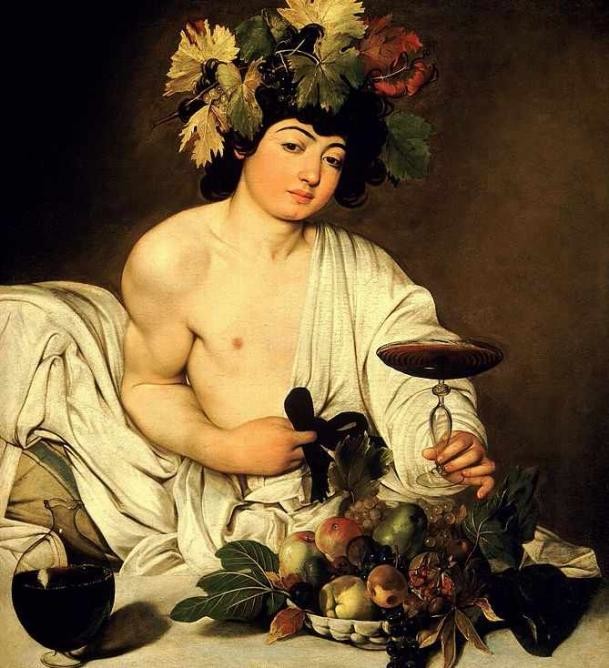
Caravaggio, Bacchus, c. 1596, Uffizi, Florence, Italy.
Bacchus was the Greek and Roman god of wine and merrymaking. He is commonly featured in narrative mythological paintings, perhaps most famously Titian’s Bacchus and Ariadne. By the 17th century, there was a fashion for images of debauched revelry, bacchanalia, which were presided over by a usually older representation of the god. Although single figures were less common, Caravaggio painted a number of sexualized images of Bacchus, usually semi-naked, glass in hand.
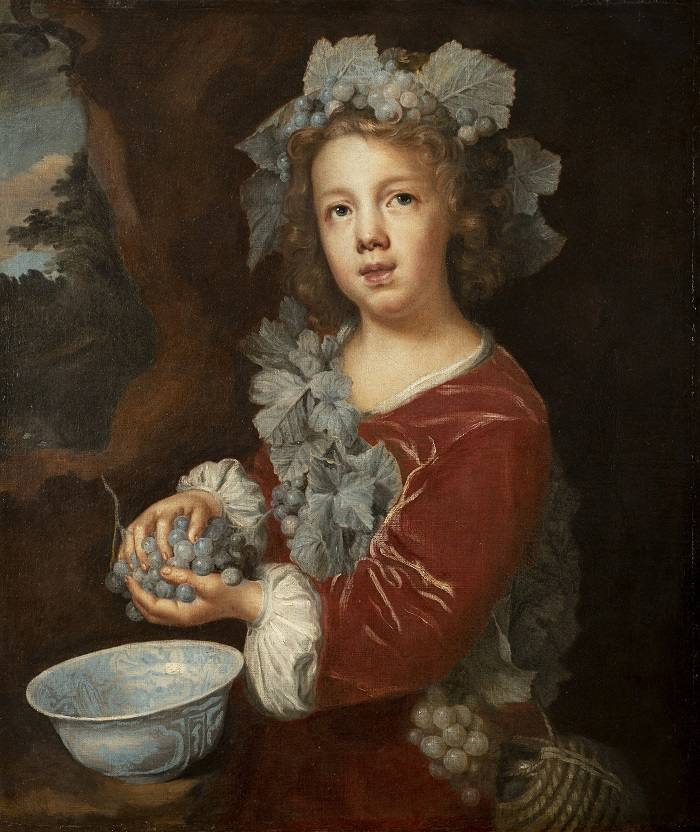
Mary Beale, Young Bacchus, 1660s, St Edmundsbury Borough Council, Suffolk, UK.
Beale’s interpretation could not be more different. Her painting is primarily a portrait of her son, clothed in contemporary dress and obviously very young and innocent. It is simply the addition of the still life, especially the grapes, the vine leaf wreath in his hair, and the flagon of wine hanging from the boy’s belt, which suggests the title.
He is not so much a Roman god as a contemporary child playing at fancy dress. Rather than looking back to Caravaggio, Young Bacchus looks forward to the 18th-century fashion for fancy pictures: pretty, whimsical images of children by the likes of Joshua Reynolds.
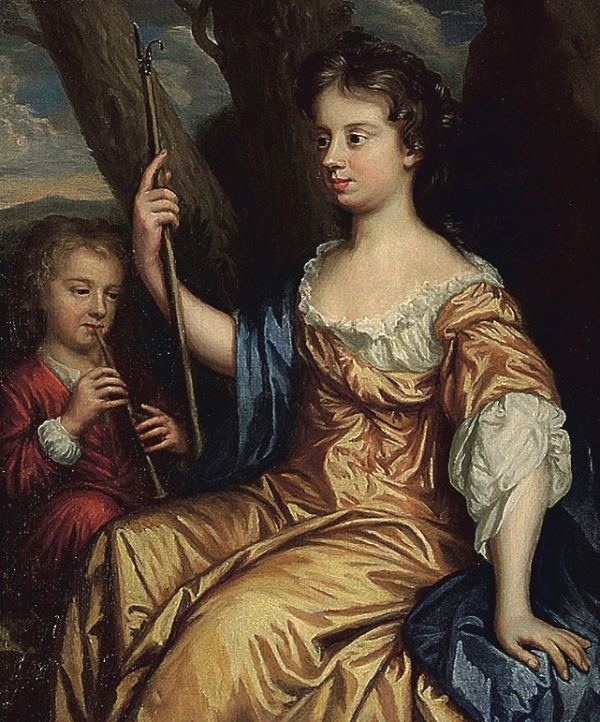
Mary Beale, Self-Portrait as Shepherdess, c. 1664, St Edmundsbury Borough Council, Suffolk, UK.
Although Mary Beale was primarily a portrait painter, she was clearly interested in pushing the boundaries of how portraiture was defined. One of her earliest recorded works shows the artist representing herself as a shepherdess, accompanied by a boy playing the flute, who was probably modeled on Batt.
It is tempting to think that the boy is wearing the same red velvet suit in both paintings, although given that he is older in the shepherdess picture, this is perhaps unlikely. There is also a record of a Beale self-portrait, now lost, in the costume of the Greek goddess Pallas Athene.
In one sense, Beale is following Peter Lely, who was experimenting with his so-called “arcadian portraits” at this time. Fashionable female sitters, such as royal mistress Barbara Villiers, were represented in the costumes of shepherdesses, goddesses, and even the Virgin Mary. Lely himself painted an unknown young boy as a shepherd with a flute.
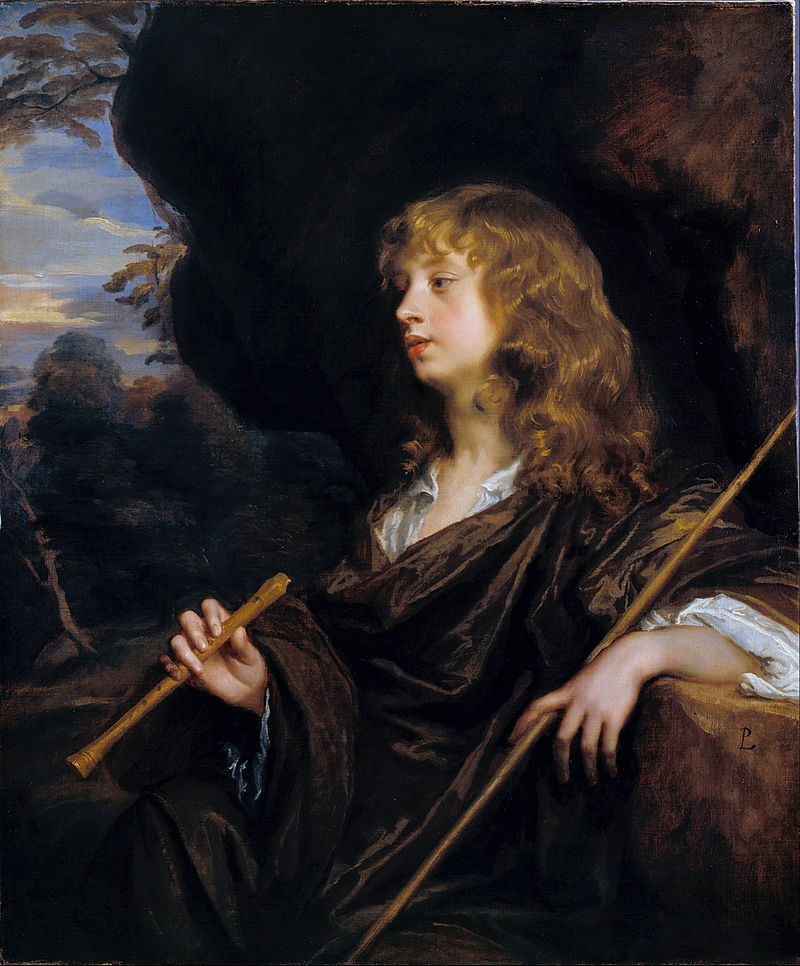
Peter Lely, Boy as a Shepherd, c. 1658–60, Dulwich Picture Gallery, London, UK.
Beale also used self-portraits like this, and like the painting of her son as Bacchus, she experimented with ideas and compositions that she would then go on to use in commissions. Thus, she later painted Jane Fox, Lady Leigh as a Shepherdess with a theme and composition similar to the self-portrait. The figure of Batt is now replaced by a very picturesque-looking sheep, which the lady is delicately feeding.
The portrait of Jane Fox, painted at the height of Beale’s professional success, is more sophisticated than the earlier self-portrait. However, the yellow and blue coloring of the draperies, the positioning of the figure in the right foreground against a landscape, and the staff she carries, all display similarities.
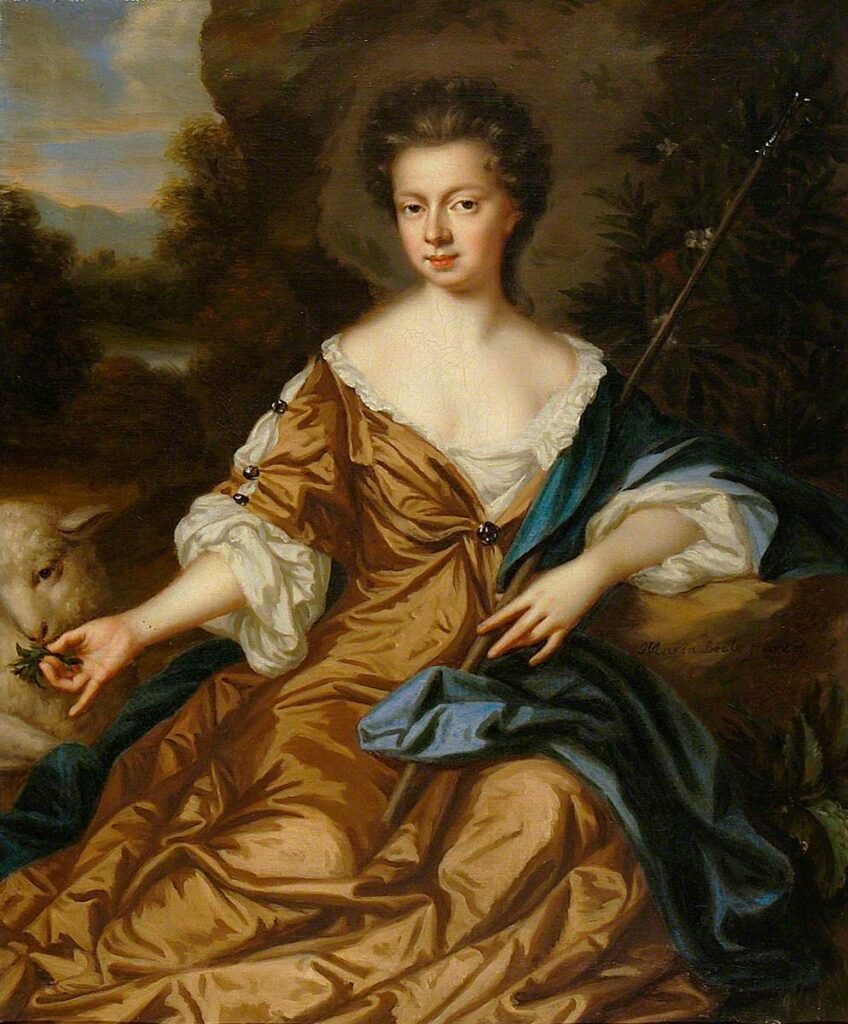
Mary Beale, Jane Fox, Lady Leigh as a Shepherdess, c. 1675, St Edmundsbury Borough Council, Suffolk, UK.
Family portraits like Young Bacchus also fulfilled another useful role. Hanging in the family’s studio home, they acted as a form of advertisement, providing an example of the kind of work commissioners could expect. Young Bacchus very effectively shows off the full range of Beale’s skills: the velvet texture and rich red coloring of his jacket; his expressive features; still life elements; landscape background; effective modeling and highlights in the folds of the sleeve; softly illuminated flesh tones. There is a good balance of broad brushwork and precision detail. And the image is striking and cute enough to attract notice.
Mary Beale produced one of the first descriptions of artistic practice by a woman with her unpublished 1663 manuscript Observations. In it, she gives a detailed description “in her painting of apricots,” which can equally be applied to the representation of the grapes in Young Bacchus. Based on careful observation, Beale distinguishes between the colors of ripe and unripe fruit and advises using ochre to “add a naturalness to the complexion of your fruit.” Although the fruit and vine leaves have lost much of their original coloring, it is clear that Beale took all aspects of her painting seriously.

Mary Beale, The Penitent Magdalene, c. 1672, Art Gallery of South Australia, Adelaide, Australia.
Beale was a figure painter, but an important part of her skill was the ability to render inanimate objects like fabric, particularly the lush silks and velvets favored by her wealthy sitters. Equally, it was important to create three-dimensionality and the appearance of the human body beneath the yards of cloth. She achieves this in Young Bacchus with no more than a few brushstrokes, suggesting the bend of the elbow, the bunching and weight of the fabric, and its sheen as it catches the light shining from above.
Objects were also an apparently minor but, in reality, a crucial aspect of portraiture, exploited to show a client’s skill set, profession, and character. In Penitent Magdalene, for instance, the subject is made clear simply by the inclusion of the ointment jar with which Mary anointed Christ’s feet.

Mary Beale, Young Bacchus, 1660s, St Edmundsbury Borough Council. Suffolk, UK. Detail.
In Young Bacchus, the grapes, wine bottle and bowl not only define the subject but create a mood of opulence and pleasure. They generate a narrative drive—the boy is about to squeeze the grape juice into the bowl. Finally, there is a symbolic element: the empty, white bowl suggests the purity of the child, emphasized by his innocent upward gaze.
Young Bacchus is, in many ways, not typical of Mary Beale’s work. Most of her surviving paintings are portraits of named adult sitters. However, it is a painting that exemplifies the abilities those sitters appreciated and, more importantly, illustrates what makes Beale such an important and interesting artist. She successfully carved out a career while enjoying a happy family life and raising her two sons. She cared about every aspect of her work, took her craft seriously, and wanted to push the boundaries of her portraiture. Businesswoman, wife, mother, artist—Mary Beale really did do it all.
Helen Draper, Mary Beale (1633–1699) and Her “Paynting Roome” in Restoration London, PhD thesis, University of London 2020. Accessed: 5 Nov 2024.
DailyArt Magazine needs your support. Every contribution, however big or small, is very valuable for our future. Thanks to it, we will be able to sustain and grow the Magazine. Thank you for your help!